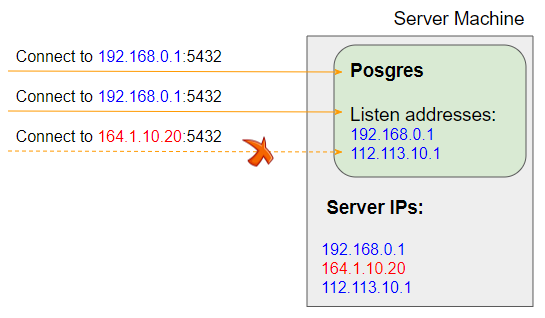
- POSTGRESQL ENABLE REMOTE CONNECTIONS HOW TO
- POSTGRESQL ENABLE REMOTE CONNECTIONS INSTALL
- POSTGRESQL ENABLE REMOTE CONNECTIONS MANUAL
- POSTGRESQL ENABLE REMOTE CONNECTIONS MAC
Below is an example on an Ubuntu machine,Īfter the DHCP Server has been installed, edit the configuration file for IPv6 address assignment. The setup is similar to the IPv4 DHCP server setup.

POSTGRESQL ENABLE REMOTE CONNECTIONS INSTALL
Install the Router Advertisement Daemon (radvd) on PostgreSQL server side, Once the host receive the router advertisement, it will use the prefix to generate the global IPv6 address automatically. The router should also response to router solicitation request from any host machine.
POSTGRESQL ENABLE REMOTE CONNECTIONS MAC
The link-local can be set to derive from the MAC address of the interface, in this case, if you know the MAC of the interface then you can create the link-local address by simply copy and paste the MAC to a link-local calculator.
POSTGRESQL ENABLE REMOTE CONNECTIONS MANUAL
The interesting part is that link-local address doesn’t request a DHCP server or any manual configuration.

The link-local address will always start with the prefix fe80:: and it is generated during TCP/IP stack boot up on that interface. Not like IPv4, all the interface of an IPv6 enabled host require a link-local address.

In this blog, I will just explain some simple concepts which is required in this demo. For example, IP Version 6 Addressing Architecture defined in RFC 4291.

There are many documents and RFCs explain IPv6 in much more detail. If you check your home internet modem/router and most likely you will find the IPv6 is already enabled. * Google reports 24 countries whose IPv6 traffic exceeds 15%. * Google reports 49 countries deliver more than 5% of traffic over IPv6, with new countries joining all the time. Below is the state of IPv6 Deployment in 2018: * Over 25% of all Internet-connected networks advertise IPv6 connectivity. With the IPv4 address exhaustion issue, after about two decades, IPv6 now is finally coming into the real picture. IPv6 was developed by the Internet Engineering Task Force (IETF) in late 1998 and was intended to replace IPv4.
POSTGRESQL ENABLE REMOTE CONNECTIONS HOW TO
This blog will demonstrate how to setup PostgreSQL on an IPv6 network in Linux.īefore we dive into the detail, let’s discuss a little bit IPv6. For example, you can set it up on an IPv6 enabled network in just a few steps. PostgreSQL is a great open source database, not only because it supports lot of database features, but also because it supports different network setup.


 0 kommentar(er)
0 kommentar(er)
